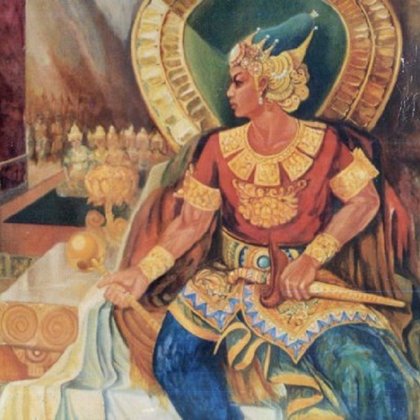THE MAJAPAHIT EMPIRE (1293 - 1500 AD) THE GOLDEN AGE OF INDONESIAN ANCIENT HISTORY ,WHICH TRANSLATES " BITTER FRUIT" .THE MAJAPAHIT WOULD ENTER IT'S GOLDEN AGE DURING THE RULE OF HAYAM WURUK.WHO WAS THE FORTH EMPEROR (1350- 1389 AD) WITH THE SUPERB ASSISTANCE OF GAJAH MADA,THE PRIME MINISTER .MAJAPAHIT WAS A KINGDOM THAT RULED MOST OF THE MALAY ARCHIPELAGO .
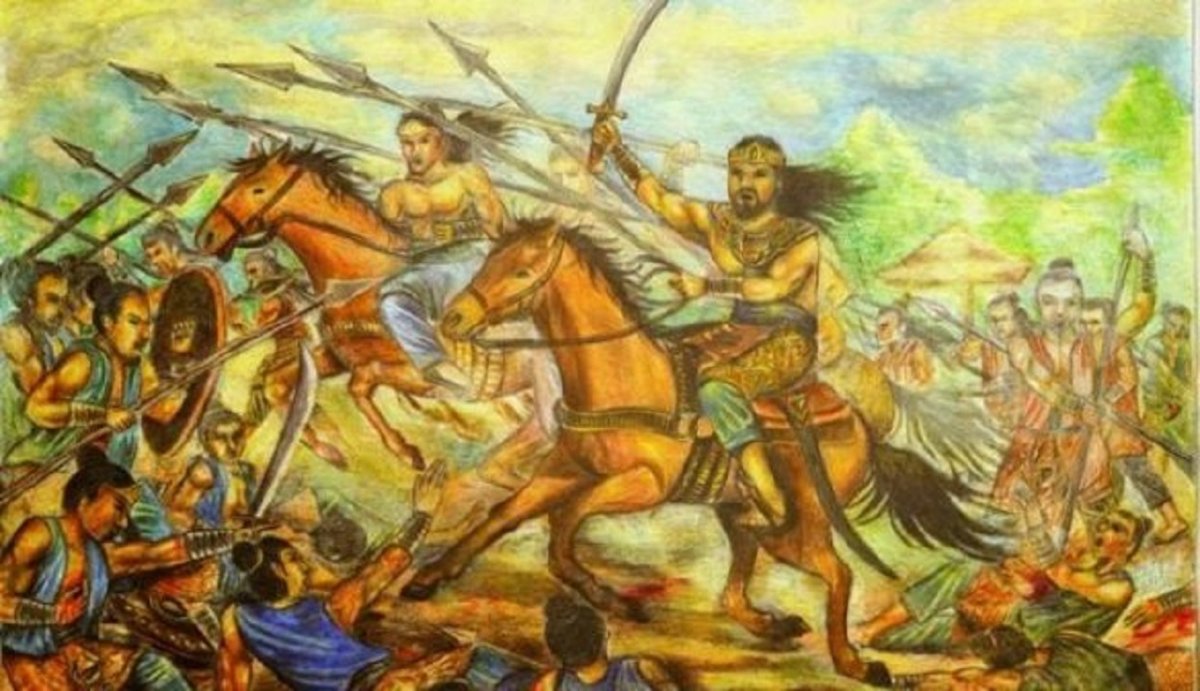
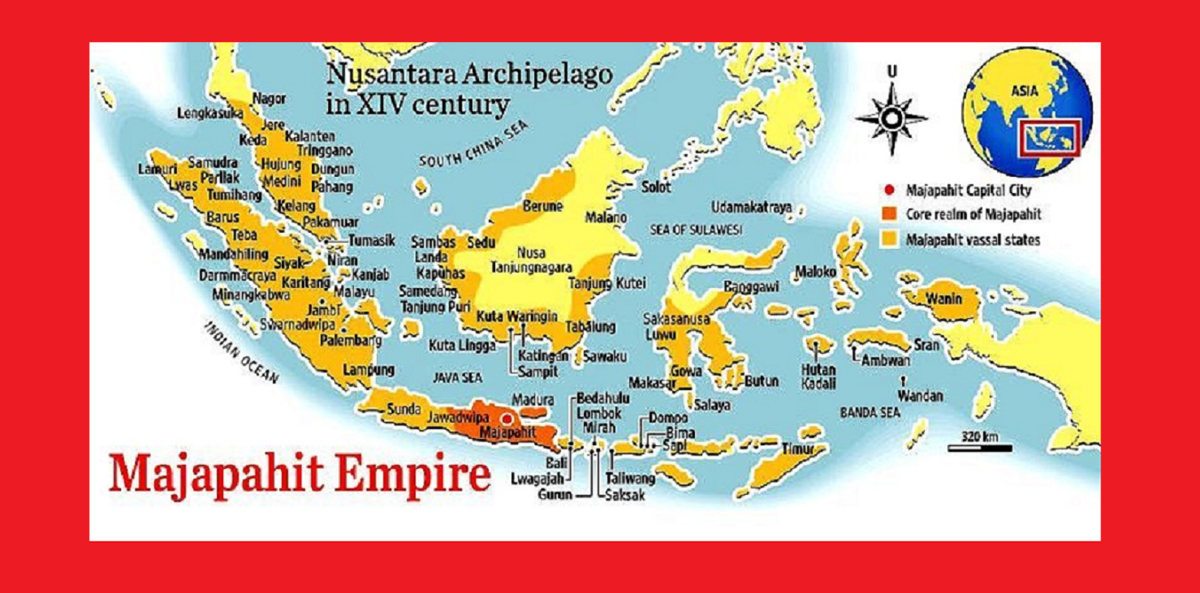 The Majapahit Empire is the last Indianized kingdom in Indonesia, dating back to 1293 – circa 1520 AD. The island empire was situated on eastern Java with the capital city of Majapahit. The empire was founded by Prince Vijaya of the Singasari dynasty. While the empire existed, medieval Indonesia reached the highest level of centralization. Entire Java was united under the power of Majapahit rulers. Later on the most developed regions of Madura, Sumatra, Sumbawa, Sulawesi, the Moluccas and the Malay Peninsula were added to the empire territory.
The Majapahit Empire is the last Indianized kingdom in Indonesia, dating back to 1293 – circa 1520 AD. The island empire was situated on eastern Java with the capital city of Majapahit. The empire was founded by Prince Vijaya of the Singasari dynasty. While the empire existed, medieval Indonesia reached the highest level of centralization. Entire Java was united under the power of Majapahit rulers. Later on the most developed regions of Madura, Sumatra, Sumbawa, Sulawesi, the Moluccas and the Malay Peninsula were added to the empire territory.
The story of a wealthy and powerful, Majapahit Empire begins at the end of the 13th century AD on the Indonesian island of Java.Majapahit was a kingdom that ruled most of the Malay Archipelago from 1293 to 1500 AD. It’s primary strength is in it’s navy and trade as it is located right within the global trade route and also an archipelago.The Majapahit Kingdom now serves as a predecessor to Indonesia, and many Indonesians see it as the golden age of their people.Javanese Kingdom with a interesting history as it started as a different Kingdom until it was invaded by the Mongols but by the time they came another kingdom already took control, then however the Heir to the previous kingdom decided to suck up to the Mongol military campaign leaders in Java which he would later betray. He used their forces to reconquer his kingdom for the promise of tribute but along the way he heard his servant pick up a fruit from a tree and say “Maja Pahit” which translates to “Bitter Fruit” and he founded the Kindom by that name after removing the rebel kingdom he promised his Mongol “Diplomats” the tribute and took them to the Capital which they would then be ambushed and the Mongol army would decide that they did what they came for and left hastily.After a few years the Kings lineage would enriched the Kingdom and then expand into other islands, but understand that in Asia empire building also included tributaries which is what mostly made up the Kingdom of Majapahit and other Indonesian Kingdoms. Due to Majapahit’s Control of the Strait of Malacca and the Spice Islands they became powerful until their fall to the Sultanate of Malacca which is why the strait is named that way.By 1365, the entire Malay Archipelago, with the exception of Sri-Vijaya and two of its colonies, were conquered by the Majapahit Empire. In 1377, Palembang, the capital of Sri-Vijaya, fell to Hayam Wuruk’s troops. The Kingdom of Singapura, an offshoot of Sri-Vijaya, was also later conquered. Nevertheless, this rival was not entirely destroyed, and its descendants would later return to cause First, the war of succession lasting four years broke out at the beginning of the 15th century AD.The Majapahit empire was the last of the major Hindu empires of the Malay archipelago and is considered one of the greatest states in Indonesian history. Its influence extended to states on Sumatra, the Malay Peninsula, Borneo and eastern Indonesia, though the extent of its influence is the subject of debate.After defeating Srivijaya in Sumatra in 1290, Singhasari became the most powerful kingdom in the area. Kublai Khan, the ruler of the Chinese Yuan Dynasty, challenged Singhasari by sending emissaries demanding tribute. Kertanegara, the last ruler of Singhasari, refused to pay the tribute. In 1293, Kublai Khan sent a massive expedition of 1,000 ships to Java.By that time, Jayakatwang, the Adipati (Duke) of Kediri, a vassal state of Singhasari, had usurped and killed Kertanagara. After being pardoned by Jayakatwang with the aid of Madura's regent, Arya Wiraraja, Raden Wijaya, Kertanegara's son-in-law, was given the land of Tarik timberland. He then opened that vast timberland and built a new village there. The village was named Majapahit, which was taken from a fruit name that had bitter taste in that timberland (maja is the fruit name and pahit means bitter). When Mongolian Yuan army sent by Kublai Khan arrived, Wijaya allied himself with the army to fight against Jayakatwang. Once Jayakatwang was destroyed, Raden Wijaya forced his allies to withdraw from Java by launching a surprise attack. Yuan's army had to withdraw in confusion as they were in hostile territory. It was also their last chance to catch the monsoon winds home; otherwise, they would have had to wait for another six months on a hostile island.In AD 1293, Raden Wijaya founded a stronghold with the capital Majapahit. The exact date used as the birth of the Majapahit kingdom is the day of his coronation, the 15th of Kartika month in the year 1215 using the Javanese çaka calendar, which equates to November 10, 1293. During his coronation he was given formal name Kertarajasa Jayawardhana. The new kingdom faced challenges. Some of Kertarajasa's most trusted men, including Ranggalawe, Sora, and Nambi rebelled against him, though unsuccessfully. It was suspected that the mahapati (equal with prime minister) Halayudha set the conspiracy to overthrow all of the king's opponents, to gain the highest position in the government. However, after following the death of the last rebel Kuti, Halayudha was captured and jailed for his tricks, and then sentenced to death. Wijaya himself died in AD 1309.Under the ruler Hayam Wuruk (1350-89) and the military leader Gajah Mada, it expanded across Java and gained control over much of present-day Indonesia—large parts of Java, Sumatra, Sulawesi, Borneo, Lombok, Malaku, Sumbawa, Timor and other scattered islands as well as the Malay peninsula through military might. Places of commericial value such as ports were targeted and the wealth gained from trade enriched the empire. Majapahit’s writers continued the developments in literature and wayang (shadow puppetry) begun in the Kediri period. The best-known work today is Mpu Prapañca’s Desawarnaña, often referred to as Nāgarakertāgama, composed in 1365, which provides us with an unusually detailed view of daily life in the kingdom’s central provinces. Many other classic works also date from this period, including the famous Panji tales, popular romances based on the history of eastern Java that were loved and borrowed by storytellers as far away as Thailand and Cambodia. Many of Majapahit’s administrative practices and laws governing trade were admired and later imitated elsewhere, even by fledgling powers seeking independence from Javanese imperial control.
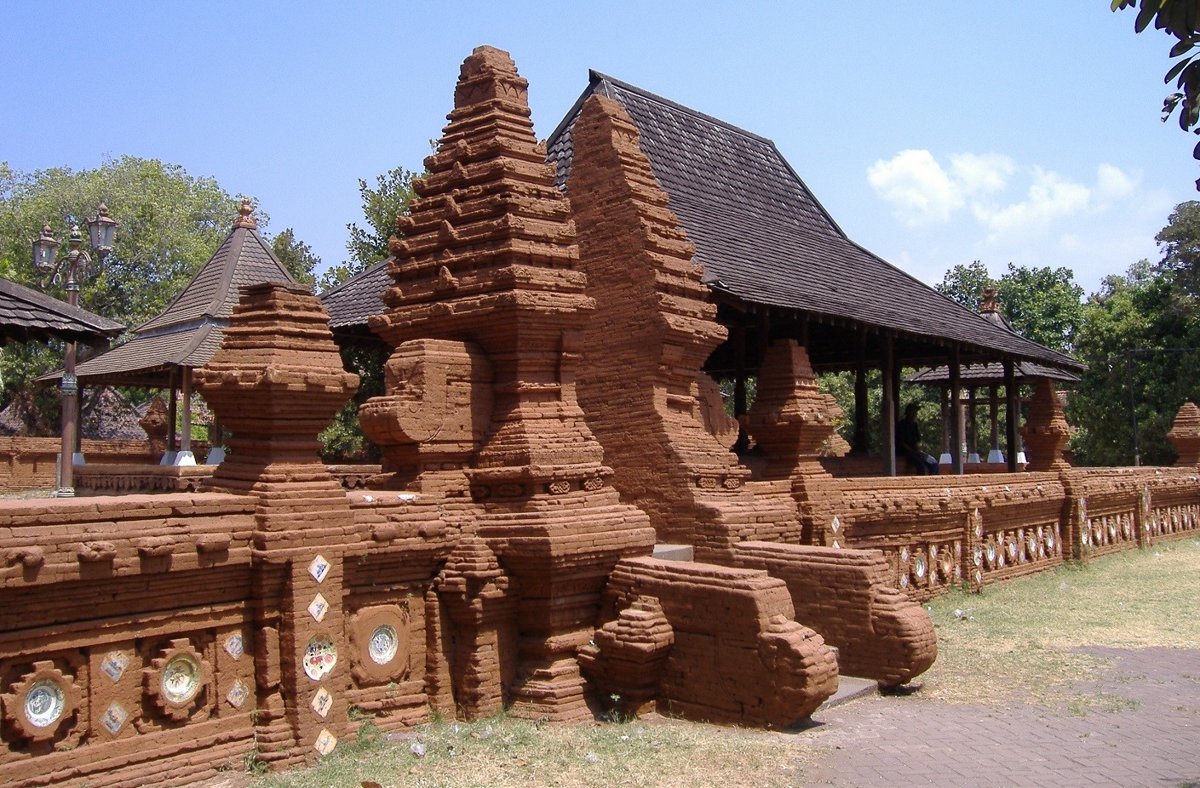
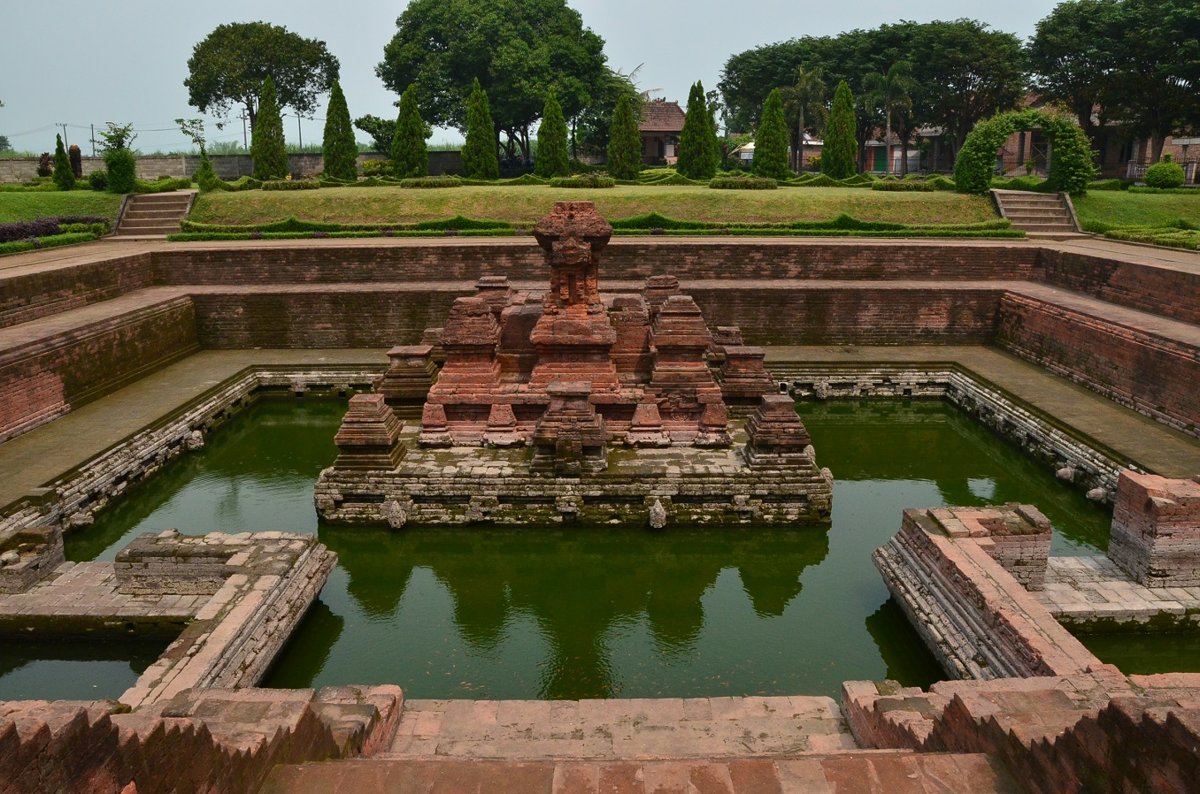 Although being called ‘candi’ (temple), this is actually more like a
bathhouse,mostly located in Trowulan . Trowulan is one of the capitals of
Majapahit in the past, and now, it becomes the most important Majapahit
site in Java. This beautiful bath pond was built in rectangle shape, made
of red bricks and surrounded with terraces. It has a main structure that
was inspired by Mount Mahameru. It is called Candi Tikus (Rat Temple)
because the pond was inhabited by rats when discovered in 1914.
Although being called ‘candi’ (temple), this is actually more like a
bathhouse,mostly located in Trowulan . Trowulan is one of the capitals of
Majapahit in the past, and now, it becomes the most important Majapahit
site in Java. This beautiful bath pond was built in rectangle shape, made
of red bricks and surrounded with terraces. It has a main structure that
was inspired by Mount Mahameru. It is called Candi Tikus (Rat Temple)
because the pond was inhabited by rats when discovered in 1914.
Before the formation of the Majapahit Empire, most of Indonesia was ruled by the Singhasari Kingdom.Raden Wijaya, who would be the founder of the Majapahit Empire.Jayakatwang, the last ruler of the Singhasari Kingdom.Chinese sources paint Kertanegara as being a rebellious vassal.“Kertanegara had refused to pay tribute to the Yuan Dynasty, mistreated the Yuan envoy, and even challenged Kublai Khan. As a result, the Emperor decided to punish Kertanegara by dispatching 1000 ships to subdue his kingdom.”In contrast, Javanese sources paint Kertanegara as a friendly vassal.“The expedition sent by Kublai Khan to Java was not meant to punish Kertanegara, but to aid Raden Wijaya. This is because Raden Wijaya had sent an urgent envoy to the Emperor requesting for aid against Jayakatwang. Furthermore, Raden Wijaya also promised to offer Kublai Khan the pick of the most beautiful princesses in the Singhasari Kingdom.”Regardless of two different versions, the result would still be the same.Raden Wijaya allied himself with the Mongol forces that came to Java in 1293 and defeated the usurper, Jayakatwang.After the victory, Raden was allowed to return to Trowulan to prepare the tribute to the Yuan dynasty. But, Raden had no intention to become a Mongol vassal state. He wanted a sovereign empire.That’s why he decided to force out the expedition force out of Java, for good. He launched a surprise attack on the Mongol army camp, surprising and demoralizing them. He inflicted heavy losses for the Mongol force (3000 Mongol force casualties) and forced them to withdraw to China.Shortly after this victory, Raden Wijaya was crowned as the first emperor of the Majapahit Empire, that slowly started its expansion.It had a great strategic position on the spice trade route that increased the wealth of the empire immensely ,they could levy duties on the goods that were shipped through its area of control.An Indianized kingdom, Majapahit was the last of the major Hindu empires of the Malay archipelago and is considered one of the greatest states in Indonesian history. In Singhasari, which defeated Kediri in 1222, there arose an aggressive system of state control, moving in new ways to incorporate local lords’ rights and lands under royal control and fostering the growth of mystical Hindu- Buddhist state cults devoted to the powers of the ruler, who came to be accorded divine status.The greatest and most controversial of Singhasari king was Kertanagara , the first Javanese ruler to be accorded the title of dewaprabu (literally, god-king). Largely by force or threat, Kertanagara brought most of eastern Java under his control and then carried his military campaigns overseas, notably to Srivijaya’s successor, Melayu (then also known as Jambi), with a huge naval expedition in 1275, to Bali in 1282, and to areas in western Java, Madura, and the Malay Peninsula. These imperial ambitions proved difficult and expensive, however: the realm was perennially troubled by dissent at court and rebellion both at home and in the subjugated territories. After defeating Srivijaya in Sumatra in 1290, Singhasari became the most powerful kingdom in the area. Kertanagara provoked the new Mongol rulers of Yuan Dynasty (1279–1368) China to attempt to check his expansion, which they considered a threat to the region. Kublai Khan challenged Singhasari by sending emissaries demanding tribute. Kertanagara, the-then ruler of the Singhasari kingdom, refused to pay tribute and so the Khan sent a punitive expedition which arrived off the coast of Java in 1293. Before the Mongol fleet of allegedly 1,000 ships and 100,000 men could land on Java, Kertanagara had been assassinated by a vengeful descendent of the Kediri kings.After Kertanagara was killed Raden Wijaya, was given the land of Tarik timberland and pardoned by Jayakatwang with the aid of Madura's regent, Arya Wiraraja. ,Raden Wijaya then opened that vast timberland and built a new village there. The village was named Majapahit, which was taken from a fruit name that had bitter taste in that timberland (maja is the fruit name and pahit means bitter). When Mongolian Yuan army sent by Kublai Khan arrived, Wijaya allied himself with the army to fight against Jayakatwang. Once Jayakatwang was destroyed, Raden Wijaya forced his allies to withdraw from Java by launching a surprise attack. Yuan's army had to withdraw in confusion as they were in hostile territory. It was also their last chance to catch the monsoon winds home; otherwise, they would have had to wait for another six months on a hostile island. In A.D. 1293,Raden Wijaya founded a stronghold with the capital Majapahit. The exact date used as the birth of the Majapahit kingdom is the day of his coronation, the 15th of Kartika month in the year 1215 using the Javanese çaka calendar, which equates to November 10, 1293. During his coronation he was given formal name Kertarajasa Jayawardhana. The new kingdom faced challenges. Some of Kertarajasa's most trusted men, including Ranggalawe, Sora, and Nambi rebelled against him, though unsuccessfully. It was suspected that the mahapati (equal with prime minister) Halayudha set the conspiracy to overthrow all of the king's opponents, to gain the highest position in the government. However, after following the death of the last rebel Kuti, Halayudha was captured and jailed for his tricks, and then sentenced to death. Wijaya himself died in A.D. 1309.
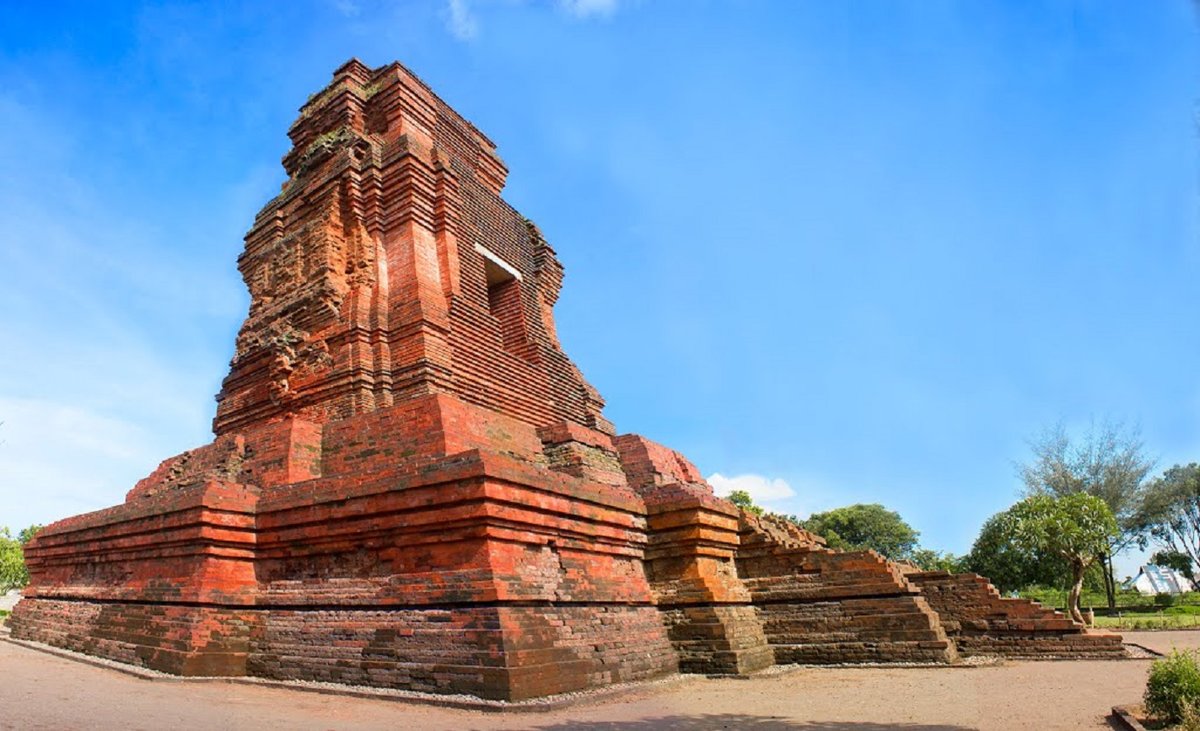 Candi Brahu is one of the most prominent Buddhist style temples at
Trowulan Site. The temple was built from red bricks and is thought to be
a special place to cremate the bodies of kings. The temple is twenty
meters high and facing the west.
Candi Brahu is one of the most prominent Buddhist style temples at
Trowulan Site. The temple was built from red bricks and is thought to be
a special place to cremate the bodies of kings. The temple is twenty
meters high and facing the west.
Based in eastern Java from 1293 to around 1500, its greatest ruler was Hayam Wuruk, whose reign from 1350 to 1389 marked the empire's peak when it dominated kingdoms in Maritime Southeast Asia (present day Indonesia, Malaysia, and the Philippines). Hayam Wuruk, also known as Rajasanagara,during his pertiod, Majapahit
attained its peak with the help of his prime minister, Gajah Mada. Under
Gajah Mada's command (AD 1313–1364), Majapahit conquered more
territories. In 1377, a few years after Gajah Mada's death, Majapahit
sent a punitive naval attack against Palembang, contributing to the end
of the Srivijayan kingdom. Gajah Mada's other renowned general was
Adityawarman, known for his conquest in Minangkabau.China also became
politically involved in Majapahit’s relations with restless vassal
powers (Palembang in 1377) and, before long, even internal disputes (the
Paregreg War, 1401–5). At the time of the celebrated state-sponsored
voyages of Chinese Grand Eunuch Zheng He between 1405 and 1433, there
were large communities of Chinese traders in major trading ports on Java
and Sumatra; their leaders, some appointed by the Ming Dynasty
(1368–1644) court, often married into the local population and came to
play key roles in its affairs. Majapahit did not unify the archipelago
in any modern sense, however, and its hegemony proved in practice to be
fragile and short-lived. Beginning shortly after Hayam Wuruk’s death, an
agricultural crisis; civil wars of succession; the appearance of strong
trading rivals, such as Pasai (in northern Sumatra) and Melaka (on the
Malay Peninsula); and restive vassal rulers eager for independence all
challenged the political-economic order from which Majapahit had drawn
much of its legitimacy. Internally, the ideological order also began to
falter as courtiers and others among the elite, perhaps following
popular trends, abandoned Hindu-Buddhist cults centered on a supreme
kingship in favor of ancestral cults and practices focused on salvation
of the soul. In addition, new and often intertwined external forces also
brought significant changes, some of which may have contributed to the
dissolution of Majapahit’s paramountcy.Majapahit is generally regarded as having been the largest premodern state in the Indonesian archipelago, and perhaps the most extensive in all of Southeast Asia. At its zenith under the fourth ruler, Hayam Wuruk (known posthumously as Rajasanagara, r. 1350–89), and his chief minister, the former military officer Gajah Mada (in office 1331–64), Majapahit’s authority appears to have extended over 20 eastern Java polities as direct royal domain; tributaries extending beyond those claimed by Singhasari on Java, Bali, Sumatra, Kalimantan, and the Malay Peninsula; and trading partners or allies in Maluku and Sulawesi, as well as present-day Thailand, Cambodia, Vietnam, and China. Majapahit’s power was built in part on military might, which Gajah Mada used, for example, in campaigns against Melayu in 1340 and Bali in 1343.Following the example of its predecessor, Singhasari, Majapahit was based on the combined development of agriculture and large scale maritime trade. According to ancientworlds.net: “In the eyes of the Javanese, Majapahit represents a symbol: that of the great concentric agrarian kingdoms relying on a solid agricultural base. More importantly, it is also the symbol of Java's first claim to pre-eminence in the Malay Archipelago, even if Majapahit's so-called tributaries were, more often than not, places known to the Javanese of that period rather than actual dependencies.Its territorial expansion can be credited to brilliant military commander Gajah Mada, who helped the kingdom claim control over much of the archipelago, exerting suzerainty over smaller kingdoms and extracting trading rights from them. After Hayam Wuruk’s death in 1389, the kingdom began a steady decline.The Majapahit Kingdom was not without its intrigues. Gajah Mada helped defeat rebels that killed King Jayanegara and then later arranged the murder of the king after the king stole Gajah Mada’s wife. Wijaya's son and successor, Jayanegara was notorious for immorality. One of his sinful acts was taking his own stepsisters as wives. He was entitled Kala Gemet, or "weak villain". In AD 1328, Jayanegara was murdered by his doctor, Tantja. His stepmother, Gayatri Rajapatni, was supposed to replace him, but Rajapatni retired from court to become a bhiksuni (a female Buddhist monk) in a monastery. Rajapatni appointed her daughter, Tribhuwana Wijayatunggadewi, or known in her formal name as Tribhuwannottungadewi Jayawishnuwardhani, as the queen of Majapahit under Rajapatni's auspices. During Tribhuwana’s rule, the Majapahit kingdom grew much larger and became famous in the area. Tribhuwana ruled Majapahit until the death of her mother in AD 1350. She was succeeded by her son, Some scholars have argued that the territories of Majapahit covered present-day Indonesia and part of Malaysia, but others maintain that its core territory was confined to eastern Java and Bali. Nonetheless, Majapahit became a significant power in the region, maintaining regular relations with Bengal, China, Champa, Cambodia, Annam (North Vietnam), and Siam (Thailand).The Majapahit Kingdom Empire was centered at Trowulan near the present-day city Surubaya in East Java. Some look upon Majapahit period as a Golden Age of Indonesian history. Local wealth came from extensive wet rice cultivation and international wealth came from the spice trade. Trading relations were established with Cambodia, Siam, Burma and Vietnam. The The Majapahits had a somewhat stormy relationship with China which was under Mongol rule.Hinduism fused with Buddhism were the primary religions. Islam was tolerated and there is evidence that Muslims worked within the court. Javanese kings rules in accordance with wahyu, the belief that some people had a divine mandate to rule. People believed if a king misruled the people had to go down with him. After Hayam Wuruk’s death the Majapahit Kingdom began to decline. It
collapsed in 1478 when Trowulan was sacked by Denmark and the Majapahit
rulers fled to Bali , opening the way to Muslim conquest of
Java.Majapahit flourished at the end of what is known as Indonesia's
"classical age". This was a period in which the religions of Hinduism
and Buddhism were predominant cultural influences. Beginning with the
first appearance of Indianised kingdoms in the Malay Archipelago in the
A.D. 5th century, this classical age was to last for more than a
millennium, until the final collapse of Majapahit in the late 15th
century and the establishing of Java's first Islamic sultanate at Demak.
After the Mataram kingdom collapsed In Java, continued population
growth, political and military rivalries, and economic expansion
produced important changes in Javanese society. Taken together, these
changes laid the groundwork for what has often been identified as
Java’s—and Indonesia’s— “golden age” in the fourteenth century.In
Kediri, for example, there developed a multilayered bureaucracy and a
professional army. The ruler extended control over transportation and
irrigation and cultivated the arts in order to enhance his own
reputation and that of the court as a brilliant and unifying cultural
hub. The Old Javanese literary tradition of the kakawin (long narrative
poem) rapidly developed, moving away from the Sanskrit models of the
previous era and producing many key works in the classical canon.
Kediri’s military and economic influence spread to parts of Kalimantan
and Sulawesi.Following Hayam Wuruk's death 1389, Majapahit power also entered a period of conflict over succession. Hayam Wuruk was succeeded by the crown princess Kusumawardhani, who married a relative, Prince Wikramawardhana. Hayam Wuruk also had a son from his previous marriage, crown prince Wirabhumi, who also claimed the throne. A civil war, called Paregreg, is thought to have occurred from 1405 to 1406,of which Wikramawardhana was victorious and Wirabhumi was caught and decapitated. Wikramawardhana ruled to 1426 and was succeeded by his daughter Suhita, who ruled from 1426 to 1447. She was the second child of Wikramawarddhana by a concubine who was the daughter of Wirabhumi.
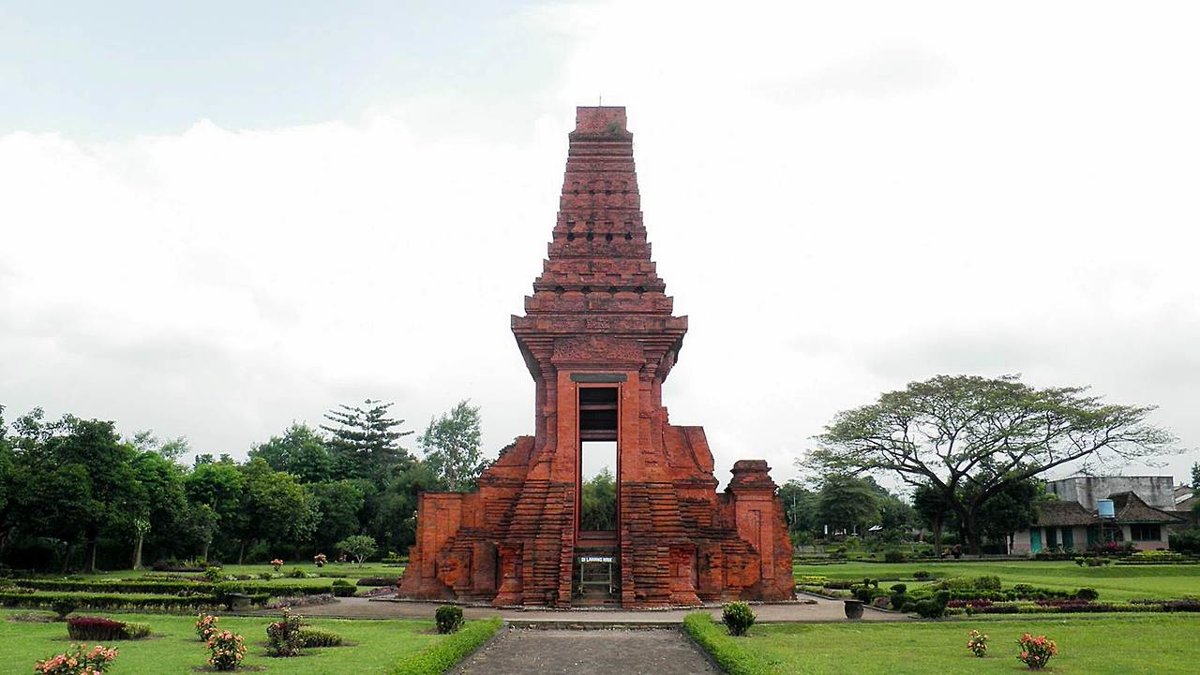 Gapura (gate) Bajang Ratu is one of numerous gates that have beautiful
and sophisticated shapes and intricate details, which are the main
characteristics of Majapahit relics. This gate was built following the
death of Jayanegara, the second king of Majapahit.This proves that Majapahit era was a diverse era, when various cultures and beliefs were accommodated.
Gapura (gate) Bajang Ratu is one of numerous gates that have beautiful
and sophisticated shapes and intricate details, which are the main
characteristics of Majapahit relics. This gate was built following the
death of Jayanegara, the second king of Majapahit.This proves that Majapahit era was a diverse era, when various cultures and beliefs were accommodated.

 The Majapahit Empire is the last Indianized kingdom in Indonesia, dating back to 1293 – circa 1520 AD. The island empire was situated on eastern Java with the capital city of Majapahit. The empire was founded by Prince Vijaya of the Singasari dynasty. While the empire existed, medieval Indonesia reached the highest level of centralization. Entire Java was united under the power of Majapahit rulers. Later on the most developed regions of Madura, Sumatra, Sumbawa, Sulawesi, the Moluccas and the Malay Peninsula were added to the empire territory.
The Majapahit Empire is the last Indianized kingdom in Indonesia, dating back to 1293 – circa 1520 AD. The island empire was situated on eastern Java with the capital city of Majapahit. The empire was founded by Prince Vijaya of the Singasari dynasty. While the empire existed, medieval Indonesia reached the highest level of centralization. Entire Java was united under the power of Majapahit rulers. Later on the most developed regions of Madura, Sumatra, Sumbawa, Sulawesi, the Moluccas and the Malay Peninsula were added to the empire territory.

 Although being called ‘candi’ (temple), this is actually more like a
bathhouse,mostly located in Trowulan . Trowulan is one of the capitals of
Majapahit in the past, and now, it becomes the most important Majapahit
site in Java. This beautiful bath pond was built in rectangle shape, made
of red bricks and surrounded with terraces. It has a main structure that
was inspired by Mount Mahameru. It is called Candi Tikus (Rat Temple)
because the pond was inhabited by rats when discovered in 1914.
Although being called ‘candi’ (temple), this is actually more like a
bathhouse,mostly located in Trowulan . Trowulan is one of the capitals of
Majapahit in the past, and now, it becomes the most important Majapahit
site in Java. This beautiful bath pond was built in rectangle shape, made
of red bricks and surrounded with terraces. It has a main structure that
was inspired by Mount Mahameru. It is called Candi Tikus (Rat Temple)
because the pond was inhabited by rats when discovered in 1914. Candi Brahu is one of the most prominent Buddhist style temples at
Trowulan Site. The temple was built from red bricks and is thought to be
a special place to cremate the bodies of kings. The temple is twenty
meters high and facing the west.
Candi Brahu is one of the most prominent Buddhist style temples at
Trowulan Site. The temple was built from red bricks and is thought to be
a special place to cremate the bodies of kings. The temple is twenty
meters high and facing the west. Gapura (gate) Bajang Ratu is one of numerous gates that have beautiful
and sophisticated shapes and intricate details, which are the main
characteristics of Majapahit relics. This gate was built following the
death of Jayanegara, the second king of Majapahit.This proves that Majapahit era was a diverse era, when various cultures and beliefs were accommodated.
Gapura (gate) Bajang Ratu is one of numerous gates that have beautiful
and sophisticated shapes and intricate details, which are the main
characteristics of Majapahit relics. This gate was built following the
death of Jayanegara, the second king of Majapahit.This proves that Majapahit era was a diverse era, when various cultures and beliefs were accommodated.